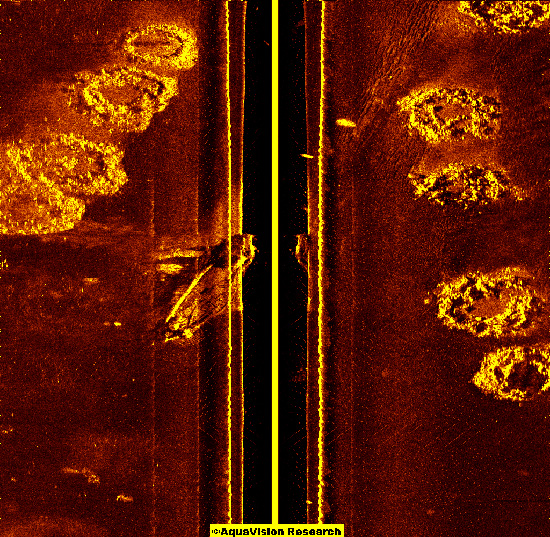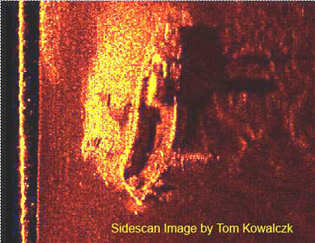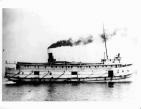City of Concord
| Ship Name: | City of Concord |
|---|---|
| Also Known As: | None |
| Type of Ship: | Wood Steamer |
| Ship Size: | 135' x 26' x 11' |
| Ship Owner: | Norman Mills |
| Gross Tonnage: | 385 |
| Net Tonnage: | 282 |
| Typical Cargo: | Coal |
| Year Built: | 1868 - Ira LaFrinier & Drake Shipyard, Cleveland as a passenger steamer. |
| Official Wreck Number: | 5538 |
|---|---|
| Wreck Location: | 41 32.730 N 82 32.808 W |
| Type of Ship at Loss: | Propeller,Wood, Bulk Freight |
| Cargo on Ship at Loss: | Coal |
| Captain of Ship at Loss: | Captain Charles McEcheran |
The City of Concord lies in approximately 40-45 feet of water sitting upright in mud. This wreck site features a rudder, engine, boiler, windlass, chain, decking, and the relatively intact hull. (Kohl)
September 27, 1906, near Point Pelee. Two lives lost. Swayze tates: "Upbound, she was struck by a gale and sprang a leak. Her fires were drowned and the vessel sank with no steam to run her pumps. The crew made it to shore in a tiny yawlboat, even though they had only one oar. Prior to this, the vessel also burned near Toledo, Ohio, in December of 1893." (Swayze)
One of the last of the old Northern Transit Company boats, the vessel was converted from a passenger steamer to a bulker in 1891 at Globe Ironworks in Cleveland, Ohio.
Greenwood states: "This oak-hulled bulk freighter was named for the capital of the State of New Hampshire. Concord is also the seat of Merrimack County and lies seventy five miles north-northeast of Boston, Massachusetts. It is situated along the banks of the Merrimack River. The city of about 30,000 population was founded in 1725, on the site of the Penacoak Indian homeland, and bore that name until 1733. In that year, it was incorporated as Rumford. Following many Indian wars in the area, including the Massacre of 1746, the site was given its present name in 1765. Industry includes the manufacture of trucks, silverware, furniture, flour, woolen goods and electrical appliances." (Greenwood)
The following account was provided from The Detroit Marine Historian Journal of Marine Historical Society of Detroit, Volume 39, Nos. 7 and 8, March - April 1986:
City of Concord - Part I
The City of Concord (U.S. 5538) was ordered by the Northern Transportation Company from E. M. Peck of Cleveland. The vessel was the second steamer completed by Mr. Peck that year, and she was launched on the morning of July 16, 1868. She was a wooden, steam-driven propeller and constructed on the same lines as the steamers Oswegatchie, Lowell and Brooklyn, although somewhat fuller in the hull. Her dimensions were 135.2 feet in length at the keel, 150 feet overall, 26.4 feet in width and 12 feet in depth. She had two decks: the lower deck for freight and the upper deck for passengers. The passenger accommodations consisted of nineteen first-class staterooms. The cabins ran nearly the entire length of the upper deck, except for about twelve feet at either end. Atop the cabins at the bow was an octagonal pilot house, eighteen to twenty inches higher than the other steamers of the line. Her lower deck was accessible through three gangways on each side. The steamer carried a single mast, located a short distance behind the pilot house. Motive power for the vessel came from a high-pressure, non-condensing engine with a twenty-six-inch cylinder and a thirty-six-inch stroke, built by the Atlantic Works of Boston, Massachusetts. The steamer was enrolled at Cleveland and measured 440.93 tons.
The Chicago to Odensburg run seems to have suited the City of Concord. Although her way ports varied from year to year, the steamer operated without incident from 1868 through the 1870 season. This may be partly attributed to the skills of her masters during these years. Captain Russel Smith was her master from 1869 and Captain A. McGrary in 1870. In March of 1871, the Northern Transportation Company fell into the hands of the Central Vermont Railroad, and with that, the steamers of the line had painted on their quarter "C.V. Line". With the new markings and a new master, a Captain William Rolls, the Concord stared a new season. Even with good men at the helm, in the 1800's it was nearly impossible to keep a boat out of the dangers that seemed to lurk everywhere. In the crowded Chicago River on July 8, 1871, the City of Concord was involved in her first accident. She collided with the schooner Sweepstakes, badly damaging the schooner. The damage to the steamer was minimal, and she was not interrupted from her regular duties. A little more than a month later, on August 12, while the steamer was at Port Colborne preparing for to transit the Welland Canal, a porter, Walter Mott, fell overboard and was drowned. Finally, in late October, on the 24th, the steamer ran aground near the pier at Port Colborne. She was not alone in her grounding for she was joined there by the schooner Reindeer. The grounding was due to low water and when the water once again rose, both vessels were easily freed and apparently uninjured.
In 1872, Captain Rolls was once again assigned to the City of Concord. The vessel's port of call on the run from Ogdensburg to Chicago, were Detroit, Duncan City, Mackinaw Island, Leland, Grand Haven, Sheboygan and Milwaukee. Not all events that happened to a vessel were the disaster type. On September 26th, the City of Concord and her officers and crew were pronounced heroes when they succeeded in rescuing the crew of the propeller Dalhousie, which burned on Lake Ontario. The crew of the Dalhousie would have certainly perished if it had not been for the opportune appearance of the Concord.
The 1873 season began with a change in routes for the City of Concord. She now ran out of Buffalo to Chicago, with way stops at Detroit, Port Huron, Presque Isle, Cheboygan, Mackinaw, Glen Haven and Milwaukee. With the change in route also came a new master, Captain Charles Ely. Most of the season was uneventful, but on September 28th, while off Milwaukee, the steamer collided with the scow Sea Bird. The scow was heavily damaged, but remained afloat. The Concord was only slightly damaged. Both vessels made port, were repaired, and continued operations. Economic conditions also went sour at about this time on the lakes. The Panic of 1873 sent the economy into chaos, and this would play a major role in the future of the City of Concord.
In 1874 the ports of operations once again were changed for the steamer. She once again ran from Ogdensburg to Chicago, with way ports in between. On one of these runs, in mid-May, the steamer went aground on Feather Bed Shoal, located about two miles below Cape Vincent. She was bound up having just cleared from Ogdensburg earlier in the day. The stranding was not bad as she was easily pulled off the next day. There apparently was little or no damage as a result of the grounding, and the vessel continued on her way. Except for this minor mishap, things went very smooth for the steamer. The same could not be said for the Northern Transportation Company, which like most companies in 1874, was trying to maintain some profitability in the face of a poor economy. Freight rates dropped continuously throughout the season, resulting in many vessels laying up early. Another contributing factor was the loss of the steamer Brooklyn by explosion of her boiler. Not only was the vessel a total loss, but fourteen persons lost their lives.
By the beginning of 1875, the poor economic conditions had not improved. A disagreement between the Central Vermont Railroad, operators of the boats of the Northern Transportation Company, and the Ogdensburg & St. Albans Railroad, prevented the operations of the boats of the line. The Northern Transportation Company went into receivership. The boats remained idle until mid-August of 1875. Then, on about the 13th, the courts appointed Mr. A.W. French as receiver, and Mr. Chamberlain as a manager of the interim operations. One by one the boats of the Northern Transportation were fitted out and began operation. Exactly what date the City of Concord began operations is unknown, but she did operate that season. On November 1, the Concord grounded at Erie. The following morning after lightering off bout 190 tons of coal, she was pulled free by the government steamer Commodore Perry. She continued on her upbound journey.
During January of 1876, the vessels and property of the former company were systematically put up for auction at the various ports. Thus, all of the vessels were disposed of. (It should be noted that all the vessels and all the property of the former company were purchased by Mr. Philo Chamberlain of Cleveland, the former manager and president of the Northern Transportation Company Line.) On January 28th, the City of Concord was sold at assignee's sale at Chicago. In late March, he, along with some of the former officers of the Northern Transportation Company, organized a new line called the Northern Transit Company. They operated the boats over the same route as before. Mr. Chamberlain maintained this operation until the end of the 1881 season. At this point it was no longer profitable to keep the present boats in operation. The Welland Canal was being expanded to handle larger vessels of up to 270 feet. Thus the boats of Northern Transit were too small to compete profitably in the enlarged canal. During the years when the steamer was operated by the Northern Transit Company, the City of Concord was involved in only one minor mishap. The steamer was bound up for Milwaukee. On November 10th, 1877, she was on Lake Huron when she was overtaken by a gale and a snow storm. In the gale she lost her direction and struck on Forty Mile Point. Although not delayed, she was damaged and began to leak. Her crew was put to work on the pumps but could not keep the water from gaining. When the steamer made Sheboygan, she had some twenty-two inches of water in her hold. A steam pump was secured by her master and she continued onto Milwaukee where repairs were made.
During the winter of 1878-1879, the City of Concord and Garden City, both of the Northern Transit Company, were chartered to run between Chicago and Ludington. She performed her job adequately with occasional periods spent trapped in the ice. (It is very possible that the Concord was chartered for other winter service during her tenure with the Northern Transit Line.)
In the spring of 1881, the City of Concord was sold by the Northern Transit Company to W.F. Botsford and others of Port Huron. Under their ownership, the Concord seemed to have been engaged primarily on the St. Clair River and Detroit River. On one of these voyages, while at Port Huron on Monday, October 17, 1881, fire was discovered on board the vessel. She had been loading hay at Parson, Canfeld and Companies' dock when the fire was discovered above her boiler. It was quickly extinguished, but not before $120.00 damage had been sustained by the vessel. A little over a month later, another fire broke out aboard the steamer. This time she was entering Lake St. Clair from the Detroit River, on Saturday, November 26th. Flames were discovered in the lamp room aft. The alarm was given, and the vessel's fire hoses were used to extinguish the blaze. This time the vessel did not get off so lucky. Damage was considerable as the result of the fire and water. Also, Captain Frank Hebner, master and part owner of the vessel, was badly burned during the fire. Captain Hebner discovered the fire in the lamp room when he opened the door, and the flames leaped out, striking him on the neck and face. After the blaze, it is likely that the vessel was laid up.
With the need for repairs caused by the fire, it was decided to have the steamer rebuilt. Her cabins and upper deck were removed. This reduced the steamers tonnage to 338. She was now a steambarge. This work was done at the Wolverine dock at Port Huron. When she came out in 1882, she was chartered for the season in the lumber and salt trade between Toledo-Cleveland and Tawas. This charter was renewed right through until the end of the 1885 season. During this time the steamer received numerous repairs. During layups in 1883 and again in 1885, much work was performed on the steamer in order to improve and maintain her insurance rating. She was only involved in one minor mishap over the length of these charters, a real credit to her master, Captain Hebner. On December 4, 1885, the City of Concord, bound up for Port Hope, Michigan, was loaded with a small cargo of coal and a barge in tow. She was forced to lie behind the breakwater at Sand Beach waiting out a northeast gale. While waiting out the storm, her mooring lines broke and the steamer was driven ashore. Since the steamer was behind the breakwater, her position was not considered serious and no help was sent for. On December 5, the gale eased some, and the steamer was gotten off without help and with no damage. She left Sand Beach on the morning of December 6, but the gale returned, with heavy snow forcing Captain Hebner to seek protection once again at Sand Beach. On the 7th she once again cleared, reaching her destination.
City of Concord - Part II
During the winter of 1886-1887, W.F. Botsford completed arrangements for operating a line of vessels between Sarnia, Ontario, and Duluth in conjunction with the Grand Trunk Railroad. This organization was eventually called the Sarnia & Duluth Steamboat Company. The City of Concord, the Dean Richmond, the Wisconsin, and the Roanoke made up the ships of the line. It would appear that the City of Concord was not suited for the line, as she was the only vessel of those mentioned that was a two-decked package freighter. She probably completed the 1887 season, but it is not likely she operated for this line after that. In late March of 1888, the steamer went to the Wolverine Drydock, where she received general repairs and recaulking. Two to three weeks later, she was beginning the 1888 season by loading salt and lumber at Port Huron for ports in Ohio.
Over the next four years the City of Concord appears to have operated with little or no major mishaps. During this time, Captain Frank Hebner purchased the controlling interest in the vessel, on October 7, 1889. W.F. Botsfrod continued to hold a share in the vessel, but at this point it was reduced to a quarter share. Sometime in 1889, possibly during winter layup, the steamer received a new fire box boiler measuring 10 feet in diameter and 16 feet in length, as well as being recaulked throughout. Again, in 1891 the steamer underwent extensive repairs having a new deck put in.
On July 27, 1892, the steamer collided with the tug Chicago off Chicago. The tug, a vessel of the Dunham Line, was overturned and sunk in Lake Michigan two miles off Hyde Park. With the sinking of the tug, two men lost their lives: the steward, Oscar Page, and linesman William Kopfer, as they were in the cabin asleep at the time of the accident. The three remaining crewman of the Chicago were rescued from the water by the steamer. The cause of the accident was disputed, with Captain Brandstretter claiming that the steamer sheered off her original heading, capsizing the tug, and Captain Hebner and the men of the Concord stating the tug attempted to cut across the bow of the steamer.
After the collision, things returned to normal. The 1883 season also appeared as though it was going to be trouble-free, but on December 2, The City of Concord and her consort, Dunford, went aground in Maumee Bay while on a trip from Toledo to Port Huron loaded with coal. The steamer had attempted to proceed to Port Huron through ice in the bay that was eight inches in thickness. She proved unequal to the task and grounded on the north side of the channel. Later that night, the water levels rose, shifting the two vessels, pushing them solidly aground on the south side of the channel. On Saturday, the tugs Schenk and Roy went to their assistance. They cleared a channel but were unable to release either vessel, snapping several lines in the process. Further efforts were suspended by the tugs. On Monday, December 4, the crew of the two grounded vessels began jettisoning some of the cargo overboard. On Tuesday, the tug Roy succeeded in getting both vessels free. Captain Hebner attempted to continue the interrupted voyage but got only as far as Stony Point, a mile or two north of Monroe, Michigan, when he decided to turn back. The ice in the lake was a good six to eight inches thick and didn't appear to be thinning out at the approach to Detroit. In addition, since neither vessel was sheathed with iron at the water line, Captain Hebner feared that the ice might puncture the hulls.
On arrival back at Toledo, preparations were begun to layup the vessel. That night, December 7, at 9:00 p.m., the steamer caught fire. Although the origin of the fire was not known, it undoubtedly started in or around the engine or boiler rooms, as the flames were first discovered issuing from around the smokestack. The fire spread so rapidly that if it had not been for the timely arrival of the Toledo Fire Department, the City of Concord would have been completely destroyed. As it was, the entire aft end of the vessel was almost completely burned away. In addition, the next morning the steamer sunk up to her main deck at the slip where she burned, with just her cabins above water. Captain Baker, wrecker, was hired on about the 20th of December, to raise the vessel. He began to work almost immediately. He boxed the steamer in and then placed pumps on her and pumped her out. This was completed and the City of Concord was raised by December 28. In mid-January a survey was held on the steamer and the damages were set at $9,800.
It had been originally thought that the City of Concord would be towed to Port Huron, when weather permitted, so that the steamer might be rebuilt there. However, these plans were never carried out. The steamer sat un-repaired through the 1894 season and the beginning of 1895. In June of 1895, the Concord was purchased by McMoran & Company of Port Huron. Apparently, McMoran rebuilt the vessel and sold it in September of 1895 to Nelson Mills and others of Marysville, Michigan. The only real change in the steamer's appearance as a result of the rebuilding was a second mast.
The City of Concord ran with almost no mishaps while owned by Mills. The only exception occurred on September 29, 1900, when the vessel went aground at the head of Walpole Island and the St. Clair River. The vessel, which was upbound light, went out three feet forward. She was pulled off several days later, apparently uninjured.
In April of 1901, the Concord became the property of the Port Huron Navigation Company. This was not really a major change in ownership, for Nelson Mills is given as president of the company. By 1903, the steamer had been around 35 years, and she was showing her age. The insurance underwriters had refused to rate the hull due to its poor condition. However, this did not prevent her owners from operating her that season and the next.
In October of 1904 it was announced that the vessel would receive a thorough rebuild over the upcoming winter. The intention may have been there, but it seems second thoughts were given to the rebuild, and apparently the conclusion was made not to rebuild the vessel. The Concord, thus began 1905 more or less the same as she had finished the 1904 season. It would be safe to say that by 1906 the situation could not have improved. This is fairly obvious from the fact that on May 23, after having loaded 476 tons of coal at Cleveland, she sprang a severe leak shortly after clearing the harbor. Her master, Captain Sewell Moore, brought her about only to have her sink inside the harbor at Cleveland. Apparently wrecking operations were begun immediately by Walter Metcalf but were unsuccessful. He abandoned the effort. A second attempt was made by D.M. Davis, which involved the lightering of her deckload and the building of a cofferdam about the vessel on June 15th. The City of Concord was repaired in just over a week at Cleveland and cleared for Port Huron by June 25th. (Considering her deteriorated condition, it would seem that considerably more time would be required to make her sea-worthy.)
Late in August of that same year, on the 26th, the Concord became disabled when the towline from her consort became entangled in the steamer's wheel. Both vessels were entering the St. Clair River when the problem arose. Unable to maneuver, the steamer became unmanageable, as did her consort, the Argonaut. The tug Hand was able to get the steamer in tow, but her consort ran aground at the lighthouse. The City of Concord was taken to Port Huron, where the line was cut out of her wheel. In the meantime, the Argonaut was released and both vessels continued on their way.
Little more than a month later, fate caught up with the City of Concord. On Saturday morning, September 29, the steamer, under the command of Captain Charles McEcheran, cleared Cleveland loaded with coal and bound for St. Clair, Michigan. When she cleared, she had the barges Montpelier and Donaldson in tow, similarly loaded and destined for the same port. In addition, a third barge, the Neguanee, was to be picked up at Lorain to complete the tow. This was accomplished, and all four vessels were underway by 4:00 p.m. Saturday evening. The Concord and her consorts had not been underway for more than a few hours when a gale caught them west of Huron, Ohio. The steambarge and her consorts made little headway against the gale. At about 8:30, the Concord sprung a leak. Although the pumps were immediately started, they were unable to keep up with the influx of water. The barges were cast off, but this did little to alleviate the problem. Soon, the water reached the boilers and all hopes of saving the steamer were abandoned. Captain McEcheran ordered the yawl boat lowered and the crew to abandon the sinking craft.
The yawl was cleared from the steamer, but two of the crew, John Weiser, a watchman, and Frank Peters, a fireman, refused to leave the vessel, preferring to take their chances aboard the steamer. A third member of the crew, Roy Wakefield, a youth, apparently had considered staying with the boat rather than taking his chances in the yawl. However, as the yawl was pulling away from the listing steamer, he changed his mind and leaped from the steamer to the yawl. Unfortunately, he missed it and was not seen again by the men in the yawl. At about the same time that Wakefield made his jump for safety, the City of Concord took her final plunge.
Although clear of the sinking City of Concord, the nine members of the crew in the yawl were far from safe. The tremendous seas tossed the boat around like a top. They rowed toward the nearest of the barges, the Montpelier, but as they approached they were warned off by the barge's crew, informing them that they too were in imminent danger of foundering. Obviously not wanting to have to escape another sinking, the yawl was headed before the wind for shore. It was successfully landed some two miles east of Cedar Point.
The first reports of the loss stated that three of the crew were drowned, but Roy Wakefield, who literally missed the boat, was fortunately able to catch another in the form of the barge Donaldson. He, along with the barge, arrived safely at Huron. As for Peters and Wieser, they were lost when the steamer went down. Of the other two barges in tow of the City of Concord, the Montpelier survived and eventually reached her destination. The Neguanee, was driven ashore and became a total loss, very near the place the Concord's crew came ashore. All of the Neguanee's crew safely made it ashore.
With the sinking of the City of Concord, another of a fast disappearing breed of vessel left the lake scene. It would only be a matter of ten years or so and the wooden steamers would nearly all be gone.
(SOURCE: The Detroit Marine Historian - Journal of Marine Historical Society of Detroit, Volume 40, No. 8, April 1987 pp. 1-5 and The Detroit Marine Historian - Journal of Marine Historical Society of Detroit, Volume 40, No. 9, May 1987 pp. 1-4) from files in GLHS folder
1. Kohl, C. 2001. The Great Lakes Diving Guide. Seawolf Communications, Inc., P.O. Box 66, West Chicago, IL, 60186.
2. Mesmer, J. 1987. The City of Concord - Parts I and II. The Detroit Marine Historian Journal of Marine Historical Society of Detroit, Volume 40, No.8, April 1987 and Volume 40, No. 9, May 1987.
3. Swayze, D. 1999-2000. The Great Lakes Shipwreck File: Total Losses of Great Lakes Ships 1679-2000. http://www.oakland.edu/boatnerd/swayze/shipwreck
4. Greenwood, J.O. 1987. An Era Begins. Namesakes 1900-1909. Freshwater Press, Inc. 1701 E. 12th Street, Suite 3K-W, Cleveland, Ohio 44114-3201.








